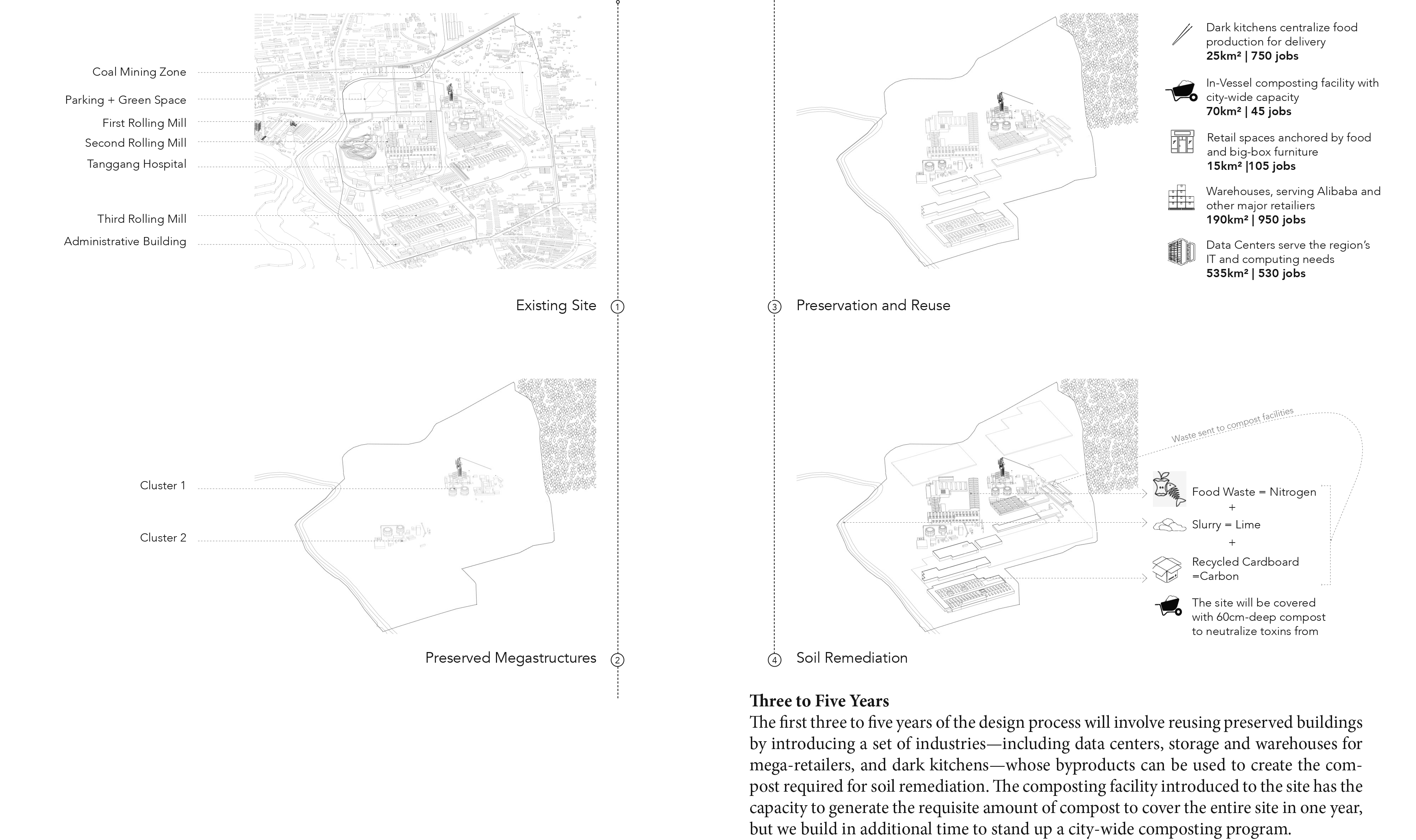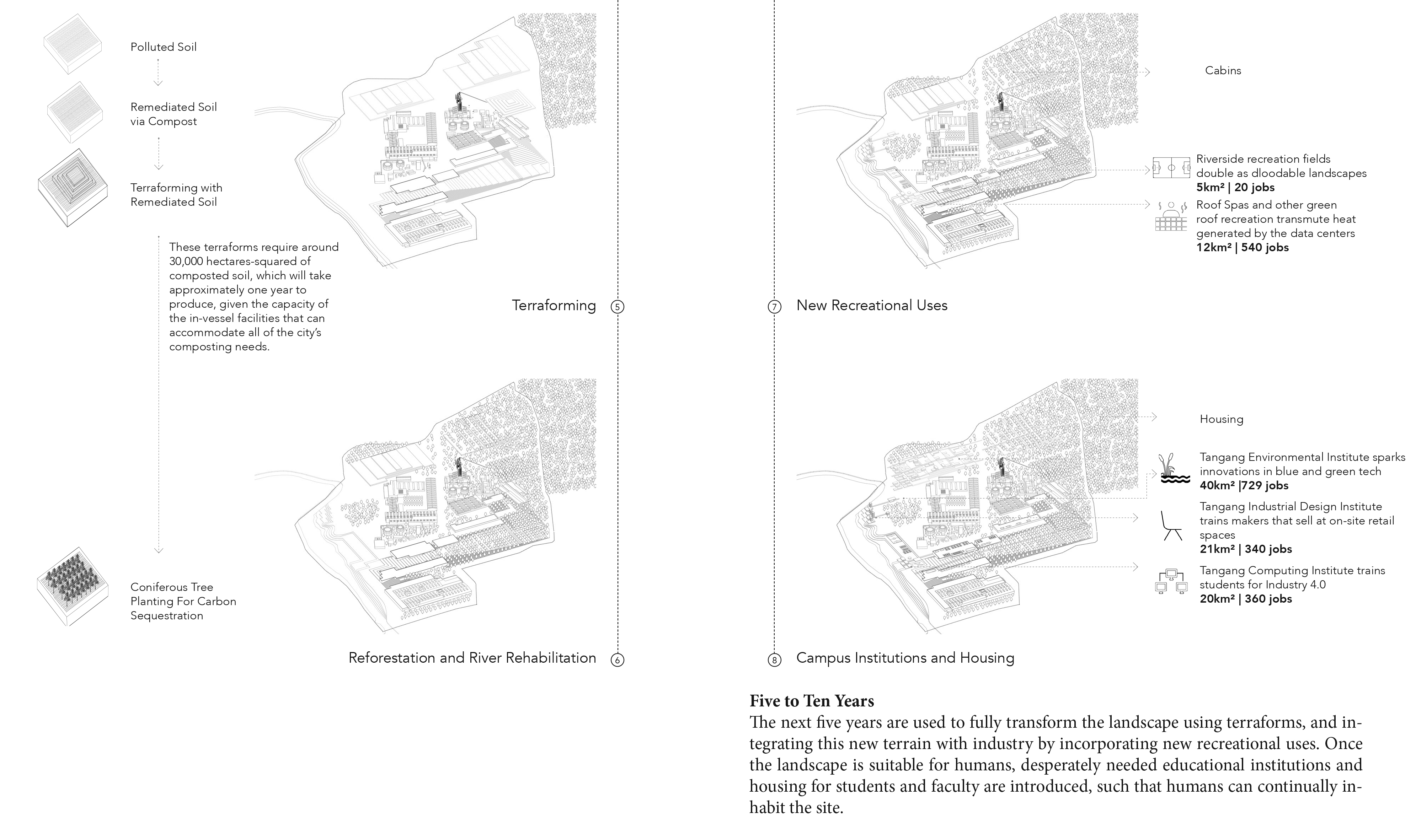Redeeming Tangang
Spectrums of Industries and EcologiesLocation: Tangshan, China
Urban Design Studio, MIT Spring 2019
In Collaboration with Feiyue Chen, Stephen Erdman and Tanaya Srini
Tangang Steel, not unlike Tangshan itself, is a site of evacuation. Once the most productive site for steel manufacturing in all of China, the city is slated to lose Tangsteel, and its 6,000 jobs, to the coast as it follows the region’s other industries in relocating to Caofeidian. In addition to lost jobs, the steel company leaves behind deep ecological scars in the form of thoroughly compacted and highly acidic soil on former mining and coal storage sites, which subsequently polluted the Dohue River through its runoff. Moreover, the Central Park-sized site is the city’s most profound reminder of its storied past as the cradle of Chinese industrial innovation. A lingering question remains: can Tangang be redeemed?
This project aims to grapple with the void left in Tangang’s absence—the environmental degradation and economic uncertainty at a massive scale—through radical landscape and future-facing industrial interventions. In doing so, we opt to design processes instead of designing outcomes, as the reality of Chinese urbanization makes predicting Tangshan’s future an exercise in futility. We employ preservation as a key strategy for celebrating the site’s industrial heritage, but intervene to create monumental terraforms that can converse with the existing scale. This ecological remediation strategy materializes by composting the byproducts of a diverse set of industries that are introduced to the site. The selected industries satisfy both the physical scale of buildings preserved and the need for human interaction with the site, while contending with industrial production’s turn towards automation. What results is not only a remediated humanistic landscape, ripe with opportunity, but also a strategy for ecological urbanism that can be applied throughout Tangshan and beyond.


Site as a Spectrum
Reading the new Tangang sectionally, by programs and landscape, demonstrate how the site functions spectrally, with denser activity and ecology on the west, “human” side, and more passive programming flowing from the “post-human” area to the site’s forest edge. The terraforms and their associated industries stitch either side of the spectrums together.





Engaging with megastructures, In preserving the most striking megastructures from Tanggang Steel, the opportunity to activate the approach to industrial heritage emerges. We create a skywalk in the forested park for visitors to engage with the megastructures from above and below, thus embracing the monumentality of their stature.

Scaling the terraces, Continuing through the forest invites exploration of the sublime terraces. As they are traversed, more of the expansive site and Tangshan’s skyline become visible above the forest roof.

Approaching the river, Reaching the top of the terraces, the landscape transitions from coniferous to deciduous planting and different seating areas offer varying spaces for conversation or reflection.

Relaxing at the spa, Rooftop recreation, including spas heated by data center emissions, are accessible via the terraces. These amenities again offer the opportunity to engage with Tanggang’s monumentality on multiple planes.

Enjoying the waterfront, As part of the site’s ecological remediation strategy, the treated Dohue River becomes a node to connect Tanggang with the city to the west, and a recreational amenity.

Experiencing culture, The riverfront is reprogrammed with storm water management features and gathering spaces for athletic and cultural activities. The multipurpose amphitheater doubles as a performance space and storm water collection basin.

Creating a home, Part of creating lasting engagement with Tanggang is ensuring the city’s young people have opportunities well into the future. By introducing new technical institutes and requisite campus housing to the site, students are provided with both a place to innovate and a space to call home.